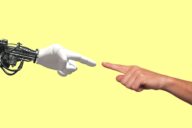 The idea of humankind being merely machines has a long history, stretching back to Julien Offrey De La Mettrie’s Man a Machine, published in 1747. The ‘man-machine’ of the 18th century was, of course, a clockwork automaton. It was not until 1945 that Norbert Weiner, in his ground-breaking Cybernetics – Or Control and Communication in the Animal and the Machine, put forward the idea of humanity as a servomechanism – a machine able to detect its own environment and respond accordingly – that the idea of humans as computerised robots began to take hold. With the development of increasingly sophisticated computerisation, the concept of artificial intelligence has taken on a life of its own. Literally, as well as metaphorically, if the recent hype is to be believed about one – albeit sacked – researcher’s claim that Google’s LaMDA, the large language model powering the Bard chatbot, has become sentient.
The idea of humankind being merely machines has a long history, stretching back to Julien Offrey De La Mettrie’s Man a Machine, published in 1747. The ‘man-machine’ of the 18th century was, of course, a clockwork automaton. It was not until 1945 that Norbert Weiner, in his ground-breaking Cybernetics – Or Control and Communication in the Animal and the Machine, put forward the idea of humanity as a servomechanism – a machine able to detect its own environment and respond accordingly – that the idea of humans as computerised robots began to take hold. With the development of increasingly sophisticated computerisation, the concept of artificial intelligence has taken on a life of its own. Literally, as well as metaphorically, if the recent hype is to be believed about one – albeit sacked – researcher’s claim that Google’s LaMDA, the large language model powering the Bard chatbot, has become sentient.
Now the drive to fuse the organic with the inanimate elements of AI hardware seems to be the inevitable next phase. Though seldom acknowledged by those engaged in this type of research, this must at least be in part because the Creator of all that is, has done such a good job with our own neural circuitry. Whilst even a cat’s brain has a 1000-fold greater storage than most iPads, the human brain’s trillion neural connections can carry out 15 quintillion operations per second.
Melbourne-based Cortical Labs have already produced computer chips incorporating human neurons produced from induced pluripotent stem cells (IPSCs). These can be created from any human tissue, such as muscle or skin. Many articles commenting on this advance have raised concerns about patient consent. Most people who have had tissue biopsies, donated blood, or even had a blood sample taken are totally unaware that such tissue and blood cells could legally be used in the UK in any research. This could include the creation of IPSCs without their explicit consent, provided the research itself has the appropriate ethical approval by the regulatory body.
Once any person’s skin cell (or any other cell) has been turned into a neuron, it then acquires the unique properties of neurons, such as the ability to self-organise into networks – an essential component of recovery from brain injury. The formation of such networks is generally accepted as a necessary but far-from-sufficient cause of the emergence of the phenomenon of consciousness. However, in the Cortical Labs microchips, the neurons are essentially acting simply as ‘biological wires’. The mere fact that they conduct electricity and can form networks does not mean that there is necessarily the possibility of any form of consciousness developing, let alone a self-consciousness of the complexity possessed by humans. Though scientists and philosophers may refer to consciousness as an ‘emergent property’, this is more a euphemism for our comparative ignorance about how basic phenomenal consciousness (having any experiences at all) develops rather than an indication that consciousness could suddenly emerge from a neuronal microchip at any moment.
Though some philosophers claim that there is only an apparent, rather than a real, scientific explanatory gap between basic consciousness and brain activity, even they emphasise this does not apply to ‘reflective consciousness, self-consciousness, or higher-order cognition’. The suggestion a sentient, latter-day Frankenstein’s monster or a golem will arise any time soon seems highly improbable. The Bible speaks of God himself breathing ‘the breath of life’ into inorganic matter, causing it to become human life made in his image (Genesis 2:7). Science has enabled us for many centuries to (slowly!) turn water into wine, and more recently, to regularly raise the (recently) dead. There is no clear scriptural teaching that says we will not, eventually, also be able to unravel how to replicate this ‘breath of life’. However, does the fact that God prevented fallen humanity from reaching out to ‘touch the tree of life and eat and live forever’ (Genesis 3:22) indicate that the ability to create life, as well as to live forever in our biological bodies, may remain beyond our grasp even in the twenty-first century?
Trevor Stammers
CMF Associate in Public Policy and Co-Editor of The Ethics of Generating Posthumans: Philosophical and theological reflections on bringing new persons into existence



